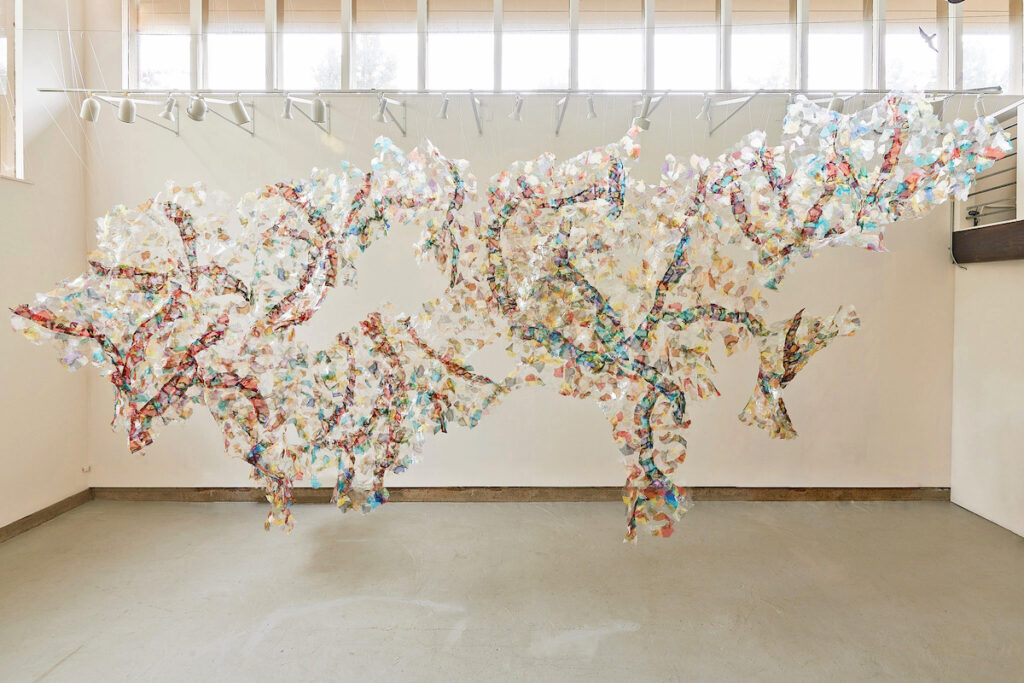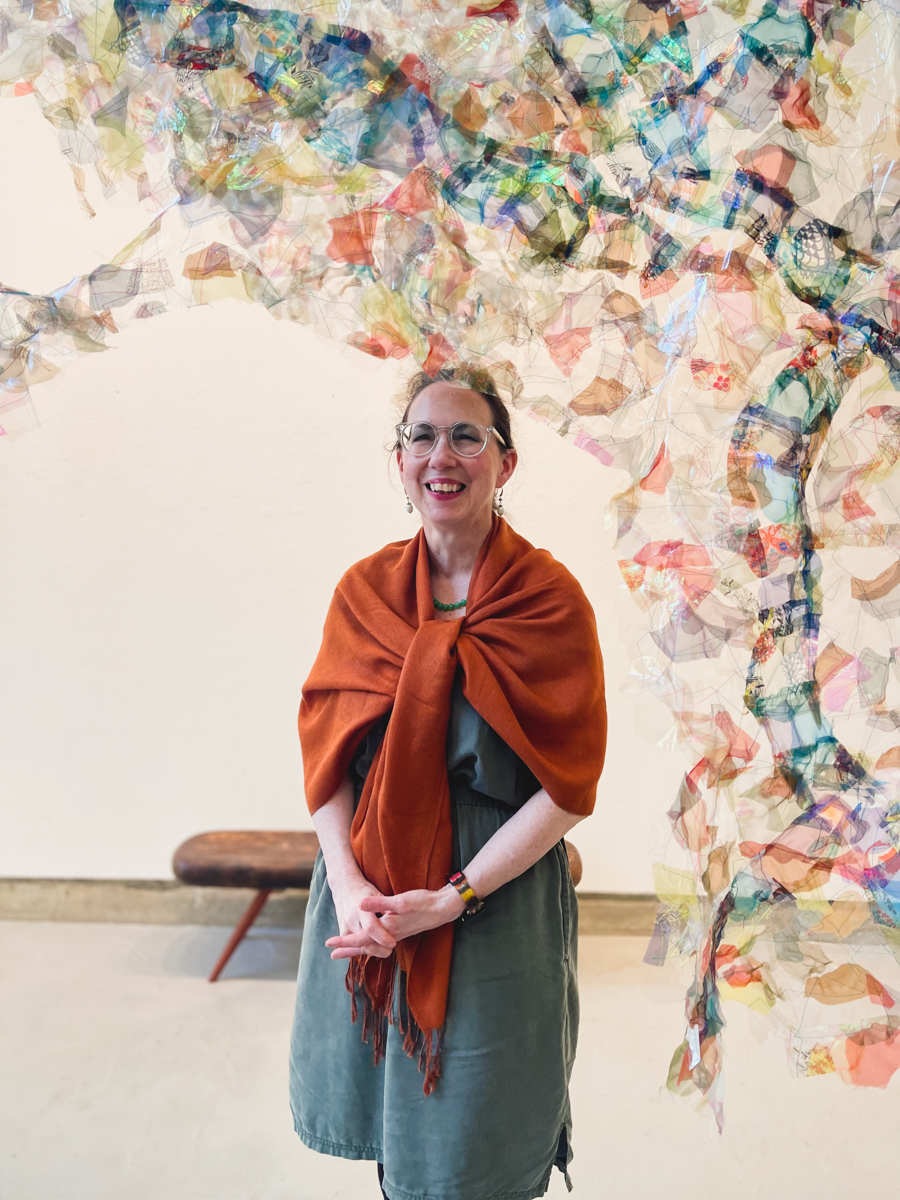On a sunny morning in Mill Valley, I took a drive through a rather jaw-dropping redwood grove up to O’Hanlon Center for the Arts, where Bay Area–based artist Holly Wong’s latest work is on display.
Wong’s pieces in O’Hanlon’s current show, “THEORY FORWARD: Shape, Line, Color, Surface/Texture,” captivated me so much that I needed a closer look at the being behind the art. As Wong and I sat on two folding chairs in the main gallery, we discussed how she was inspired to create Guardian of the Spirits, the 22-foot-long-by-12-foot-tall iridescent masterpiece hanging in front of us.
Made of silk and polyester organza, cellophane, dichroic film, vinyl tablecloth and scanned images of Wong’s paintings and drawings cut and sewn together countless times, Guardian is perhaps the most evocative piece of art I’ve seen in the last several years. It is clearly a living organism; perhaps the tangible material of a soul, or infinitely many souls, stitched and cut and sewn and connected, and utterly benign. Had I my way, I would wrap myself in it. Hanging in O’Hanlon’s daylit gallery, it quietly pulses and breathes.

Wong, the woman from whose hands and mind such a being was born, sat modestly before it, wrapped in a burnt-orange shawl. Her humility before such a masterpiece was evidence not only of the integrity, strength and honesty that went into the piece itself, but also of the years that led to its genesis.
We began our conversation.
Wong was raised in Miami, which she recalls as being, in the 1970s and ’80s, a modest retirement community. She attended the New World School of the Arts in Miami, an international arts high school where she was exposed to a diverse and culturally expressive worldview.
During high school, Wong met the sculptor Ed Love, then running the visual arts program at the New World School. Love was to become her mentor, teaching Wong about the role art played in activism, and teaching her social awareness.
“Ed introduced me to a whole generation of African-American writers,” Wong said. “It was the first time I realized my notion of privilege, and the concept of being invisible in society. I started to become aware that Ed, as he existed in the world as a tall black man, was very different than my experience as a little white girl. He taught me that we are part of an ecosystem, in which we all need to be socially aware.”
It was during this time of evocative exposure to sociopolitical circumstances and her discovery of her passion for art that Wong’s mother died of alcoholism. Wong was 14.
It was a powerful moment, where forces converged to shape Wong’s path as an artist and woman. Her mother was a victim of domestic abuse, and Wong’s family had a long history of drug and substance abuse. Wong’s awareness expanded further to include the objectification and abuse of women, the trauma women carry as a result of it, and of how fleeting and tenuous human life is.
This, along with Love’s mentorship and her developing artistic practice, converged to create a powerful nucleus that still acts as the focal point of her work. As a mentor, Love helped Wong see the value that art could play in processing grief.
“Ed felt for my loss and understood my loss, but he didn’t feel sorry for me,” Wong said. “He helped me to think about the ways in which art can be a transformational process. It was that early moment when I realized that art could be transformative and could be a force of healing.”
So began a journey of processing the abuse inflicted upon women in general—and Wong and her mother in particular—which would send her down a winding path of creating and healing.
In 1989 Wong moved to San Francisco to attend the San Francisco Art Institute. While she was also accepted to other arts schools, including Cooper Union and Pratt, Wong sought the West Coast, and distance from Florida and her family.
SFAI, Wong reflected, was like a wild animal.
“I mean, this was the sort of place where people would take their clothes off, set things on fire, and I was like, yes, I’ll do that,” Wong said, laughing. “Everybody had to go through your first semester of a) taking your clothes off, b) setting something on fire and c) cutting something up, or whatever. So everybody was working through something.”
This was 1989, and Wong was 17. She found a cathartic, loud expressivity amongst her fellow students; traumatized and damaged creatives also seeking to process what they’d experienced at tender ages.
Originally a painting major, Wong quickly began to feel confined by the rectangular boundaries of the canvas, desiring to extricate herself from both the physical parameters of her art and the psychological confinement of womanhood, sexism and exploitation of the female body—the confinement of objectification.
Wong transferred to the New Genres department, where she began getting in touch with some of the work her mother had done, including sewing, a technique used in Guardian of the Spirits and a constant theme in her work now.
“I wanted to get close to her,” Wong said. “I wanted to remember who she had been. And this kind of work, this sewing thing, started to really emerge. And I really felt that she was with me as I began sewing for hours and hours at a time.”
Before Wong realized it, her work had become feminist art. And it wasn’t enthusiastically received by the Institute, which at the time was glorifying a “bad boy” artist vibe featuring a lot of toxic-masculinity performance pieces. Wong pursued her work anyway, because “you have to be on the path you’re on.”
“A lot of my work at that time was pornography reclamation. Deconstructing pornography, scanning images, blacking-out sections,” Wong said. “I remember watching Deep Throat, and then cutting out different sections and wiping them in black and intersecting family footage; but I wasn’t sexualizing myself, I was critiquing sexual objectificiation. And I’m not anti-porn; sex-positive porn can be a very good thing. But this porn was very much the celebration of rape and the rape fantasy, and at that point I was very critical about that.”
Her work became fixated on rape, particularly as a tool of war. When Wong met her husband, Al Wong, a renowned Chinese-American artist, he taught her about the Rape of Nanking during World War II, in which Japanese soldiers raped at least 20,000 women and girls of all ages, killing and mutilating many in the process.
Wong photographed the documentation, blew up the images and created a walk-through installation including recordings of the testimonials. Her search was dark and hard, exposing the agonizing exploitation of women. She showed no mercy in her pursuits.
“Throughout all this, I didn’t understand that I was trying to process something,” Wong said. “What I understand now about trauma that I didn’t then, was that if you don’t process your own, you will live vicariously through the trauma of others. And that is what I was doing. Constantly trying to reclaim women’s safety, respect, bodies. I was trying to process something that I couldn’t reach. Couldn’t understand.”
In her early 40s things came to a head for Wong. She was diagnosed with anorexia, and began cutting herself. She sought psychiatric care and realized that the only way she was going to come back to herself was through her art.
It was then that the sewing, her story and the feminist pain began to coalesce into what her work is today, often featuring myriad cuts and mendings. Wong says that she uses this to represent the brokenness of the female body, as well as its strength—the beauty, resilience and power of the mending.
“During this time my father and both of my brothers died, and it was almost as if the ghost had been released, on some level. In a tragic way, of course,” Wong said. “But it meant that only I remained, and I could make my life what I needed it to be. I never had to be fearful again. I started making my own work after that. I was able to embrace all that I was. And owning your own story releases you.”
Hearing this story, sitting in front of the twinkling entity that is Guardian, watching it wink and breathe and glitter in the light, brought tears to both Wong’s and my own eyes.
“With Guardian,” Wong told me, “I have created my alter ego; the same one that all women contain. The bigger, stronger, more-powerful self that we can’t see, but it’s there. It’s loving, and protecting. And it takes up space. It claims space. It says, ‘I am here.’ It is expansive. It has no limitations.”
Take that, sexism.
“Guardian of the Spirits,” and all of “THEORY FORWARD,” is on view now through Aug. 31 at O’Hanlon Center for the Arts. Don’t miss it. www.ohanloncenter.org











